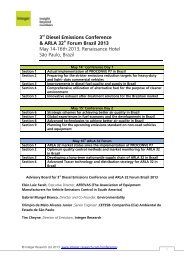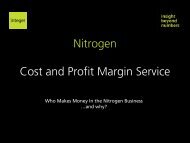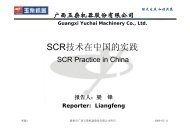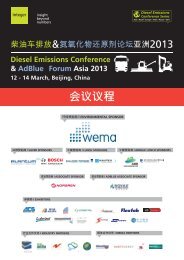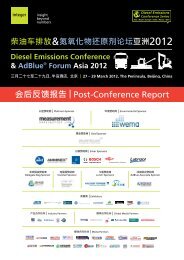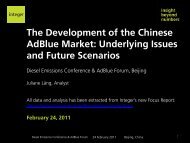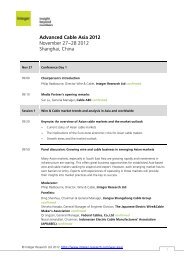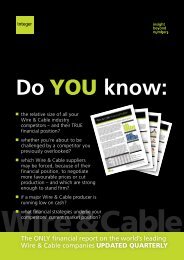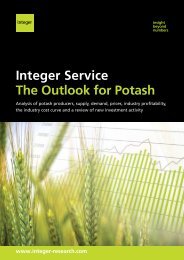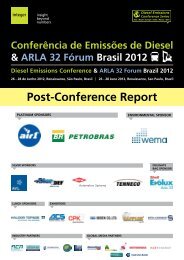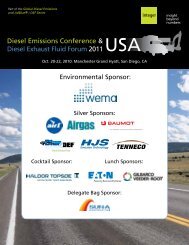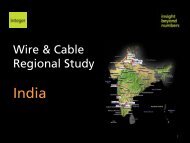Conference Summary - Integer Research
Conference Summary - Integer Research
Conference Summary - Integer Research
Create successful ePaper yourself
Turn your PDF publications into a flip-book with our unique Google optimized e-Paper software.
eyond<br />
numbers<br />
<strong>Conference</strong> <strong>Summary</strong> (cont.)<br />
insight<br />
beyond<br />
numbers<br />
Diesel Emissions <strong>Conference</strong> (Oct 19)<br />
Chamila Tissera from the Deutz Corporation kick started<br />
a day focused on the off-highway market. With a clear<br />
synergy to the previous day’s on-highway sessions, the<br />
conference discussed issues around legislation (Tier 4<br />
Interim and Final), GHG reduction and fuel economy.<br />
Chamila gave an overview of the off-highway market,<br />
and outlined the stark differences between off and onhighway<br />
certification. However, he said that the core<br />
technologies being used by the on-highway market<br />
are the same. With a 4 year gap between legalisation<br />
levels for the on- and off-highway markets, onhighway<br />
acted as the perfect “guinea pig” for these<br />
technologies. It was said earlier in the day that a ‘one<br />
size fits all’ approach does not work in the off-highway<br />
sector. Deutz are using a combination of SCR and EGR<br />
equipped trucks to achieve Tier 4 standards. However,<br />
their focus is on SCR + DPF for the heavier categories.<br />
Chamila then led into his key topic of discussion -<br />
certification - discussing the strawmen document, which<br />
was originally meant to be a guideline on ensuring the<br />
truck is achieving the emissions reduction via DEF, but<br />
eventually became law. Going step-by-step through<br />
the certification process, Chamila covered subjects such<br />
as the driver warning display lights, the requirements<br />
of a DEF sensor and freeze protection. He then went<br />
on to highlight the difficulties of establishing a DEF<br />
infrastructure for the off-highway market, especially<br />
in extreme locations. Chamila ended his presentation<br />
with some interesting data from CARB, showing<br />
the emissions results of the 8 biggest off-highway<br />
manufacturers.<br />
Joseph Featherstone from John Deere Power Systems<br />
next provided a case study on how they achieved Tier 4<br />
interim. Following an overview of the company, which<br />
offers vehicles and engines for a range of applications<br />
up to 10,000ft above sea level, he gave an insightful<br />
overview of John Deere’s strategy for achieving Tier 4<br />
interim. Joseph shared some feedback received from<br />
customers including the things they demanded from<br />
the new engines, which broke down as reliable, cost<br />
effective, powerful vehicles with a single fluid solution.<br />
Joseph went through John Deere’s building block<br />
approach, resulting in a cooled EGR with DPF solution,<br />
and went on to say that their customers were seeing<br />
fuel efficiency gains. He discussed the steps that John<br />
Deere took to get there, including educating the entire<br />
supply chain from the dealers to the customer. Feedback<br />
from their customers has shown that their solution has<br />
achieved its goals, it incurred no major disturbances<br />
to the customers’ normal operations, the new power<br />
and performance was received well, and there was<br />
satisfaction from customers that they did not have to<br />
use any additional fluids. When asked by the audience<br />
about John Deere’s view on using SCR, Joseph was<br />
unable to comment on whether this technology will be<br />
used to achieve Tier 4 Final.<br />
<strong>Conference</strong> <strong>Summary</strong>: Diesel Emissions <strong>Conference</strong> and DEF Forum, USA 2011<br />
13



